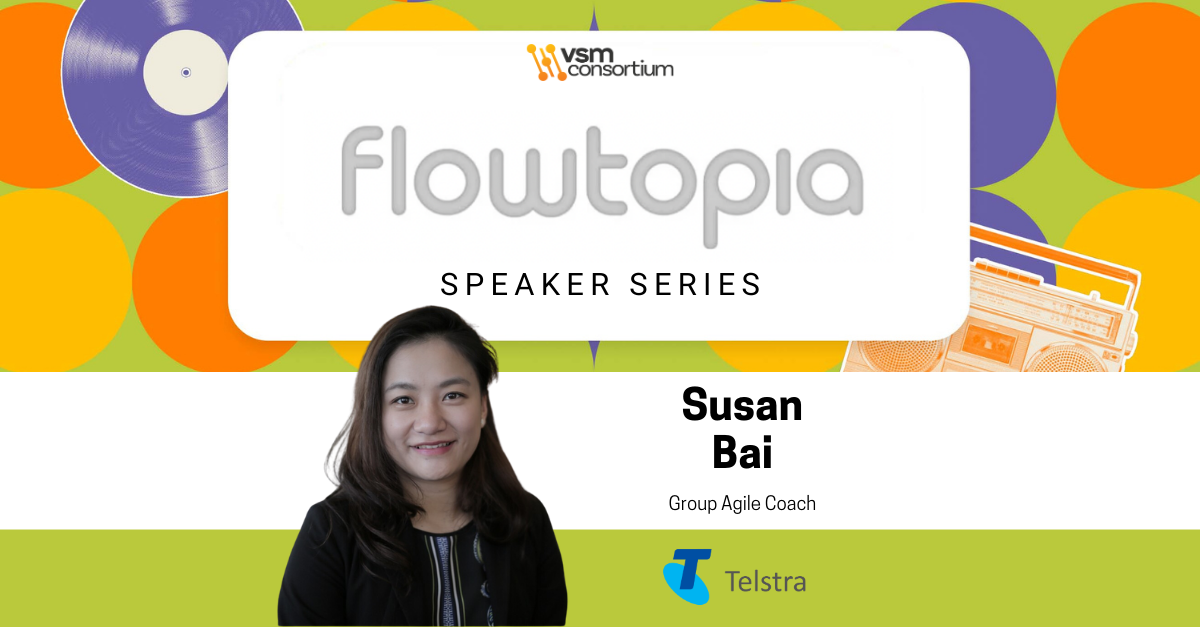This is the first in a series of blogs: ‘Value Stream Management Conversations with Steve Pereira and Helen Beal’. In this conversation, we’ll be talking about vision and visibility. In 1918 C.E. Knoeppel published diagrams showing the flow of materials and information. This is recognized as the first recorded example of what we now know as value stream management applied in the workplace. As Knoeppel put it:
“Without a knowledge of what your work is really costing you, you are in no position to say to what extent your real costs vary from what your work should cost you. You have no gauge on performance. Further, because you don’t employ time-study methods and have no definite tasks, you have no means of knowing what performance should be. Consequently, lacking standards and with no provision for measuring attainment, you can readily see that is a case of flying blindly.”
Let the conversations begin.
Helen to Steve: It’s the beginning of a new year; a time when people often revisit their plans. Lots of people set a vision and goals, and then they start running. But we rarely think about the obstacles that are likely to be in the way. What’s the opportunity here for people to really get ready for what they want to do?
Starting a new year with goals and a vision for the year ahead is so important for clarity, alignment, and energizing teams with new opportunities. We need to “Begin with the end in mind.” but we also need to periodically “Begin again.” A new year, or a new quarter, is a new chance to improve.
It’s great to get off and running towards a north star, but if we don’t consider obstacles and challenging terrain ahead - or weight we’re carrying or dragging along - we might stall before we see any progress at all.
A tactic I use to avoid these stalls or move past them is an outcome mapping exercise. It’s a workshop where a team, or a group of stakeholders come together and share ideas, perspectives, and challenges. It starts with defining a clear and valuable outcome, but goes beyond that to identify obstacles, countermeasures, and progress indicators. The result is a lot more clarity, confidence, and inclusion from the start, which means not only are stakeholders bought in, they know more about what they’re buying in to. It can mean the difference between heading off in the same direction together and individually pulling in opposing directions without knowing it.
Steve to Helen: Lots of teams have OKRs, North Star metrics, KPIs, or aspirational goals. What do you find is commonly missing for teams who have a clear direction but can’t seem to make the progress they aim for?
I actually cringe when I hear OKRs and KPIs! I’ve seen them inflicted on people so often and so misaligned. I really loved what you just wrote about the need to periodically ‘begin again’. It seems to me that there’s something intrinsic to human nature that makes us want to put a stake in the ground. Maybe it’s a craving for certainty but we seem to struggle to live in the moment and ride the change that is a continuous part of life. What I’m trying to get to is that I think people need a mindset of continuous inspection and adjustment and this applies to planning and measurement - and the measures we use.
First of all, the teams must have the autonomy to decide for themselves what their goals are; the outcome mapping exercise is a great way to get them on that path. I wonder how you might combine that with a value stream mapping exercise to get them thinking about the measurements or progress indicators they might use to track their progress to the outcomes they identify. I then think about how they can make the process of inspection data-driven and use the telemetry around them to provide empirical evidence that the desired outcomes are being achieved or within reach.
Helen to Steve: How can teams combine outcome and value stream mapping techniques and what are your top tips for making time investment in these sort of exercises really count?
When I started building value stream maps for clients I really missed the mark on outcome clarity, and as a result the maps were less valuable than they could have been. Coming from using mapping for my own teams the outcome was always clear in my mind and we’d always defined it separately to a degree that was useful. When mapping for clients you’re coming in without context, and you can’t assume everyone is on the same page or that the direction is clear. It’s also very useful to deconstruct and arrive at the outcome yourself as a facilitator so you understand more about the contributing factors. With that context you can ensure the value stream map is capturing the most valuable data for the desired outcome.
For example, a client coming to me in the hopes that we can cut their production defects in half is a very different focus than delivering twice as fast. It means focusing on a completely different facet of the value stream. It doesn’t mean we’ll ignore velocity but it does mean we won’t linger on it or invest heavily in collecting that data.
By starting with an outcome map that includes obstacles, available countermeasures, and progress indicators we can set off in the right direction and invest effort where it will contribute maximum return. We can also identify critical roles and conditions that can help us tailor inclusion and avoid potential issues down the road.
For me, effective value stream mapping is an extremely lean practice. I want to create maps quickly, simply, and effectively so that we can uncover insights and get to creating and delivering value as soon as possible. My top tip for effective mapping is to start small and invest often. Most teams who try value stream mapping spend so long doing it and create such complex maps everyone is burnt out by the end, and they not only have a map nobody wants to look at, it’s too complex to understand. I’d rather create a highly tailored map for a clear, targeted outcome in a two hour timebox, and revisit it when we need more detail or data. Another highly valuable approach is to map at separate levels (e.g. Release and Sprint, or Program and Release), with participants who are most relevant at each level. That means you’re not involving anyone not invested, things go faster, your scope is tighter, and the deliverable is right-sized to speak to the right audience. It’s important that the outcome of the mapping is delivering data-driven insights that inform action in the short term, to deliver valuable outcomes in the long term.
Steve to Helen: You mentioned team autonomy, being more present-minded and data-driven. It seems things are heading in that direction slowly but surely. What patterns or practices have you seen that help teams adopt that operating model? How do you see teams combining data, mapping and measurement on a more regular basis as just part of their ways of working?
I think it all comes down to having a continuous mindset. Like you said, doing work in small batches. Whether that’s creating a new feature for a product or spending time on improvement activities, doing it little and often is the key to adaptability. It also creates stickiness when we are working on improvement, which is always changing something about the way we work.
A key inhibiting factor for making change successful is inflicting it on people so it’s important to give value stream teams the tools they need when leadership is asking them to be empowered. There’s a tendency, a recommendation even, from some value stream mapping practitioners to include the most senior people in the exercise. I get that, from an authority point of view you want the people there who have the authority to change significant aspects of the working environment, like financial and budget models, or organizational design. But if we are distributing authority, what you really want is the people doing the work to be self-discovering their own improvements. Then they’ll truly feel accountable for the outcomes and properly investing in making it happen.
As a value stream mapping practitioner myself, one of the things that historically frustrated me was how hard teams found it to revisit their map as a continuous activity. Building it incrementally really helps with that, as you described. Doing larger, multi-day activities also results in unwieldy backlogs of work, with some activities defined in the hypothesis backlog at too high a level to be really useful. But when the data is in our heads, it’s not easy and can be time consuming to get it out.
The great realization for me was that all the data we collect in value stream mapping is available in our systems; in our DevOps toolchain. We just need to figure out how to extract it. Then we can consume it in a continuous manner, such as sprint events and practice inspecting it and adapting accordingly to what we learn. This is where the value stream management platform light bulb switched on for me. Now we have a way that teams can automated their value stream map.
Helen to Steve: Can you be specific about what data is most useful for teams to collect and when?
This is a great question and, in true consultant fashion, I’ll repeat the timeless mantra of the profession: “It depends.”
I’m a strong believer in starting from outcomes before moving forward, and in the case of measurement it’s absolutely essential. When I map outcomes with a team, we follow a desired outcome with an examination of why we want it, obstacles that may affect reaching it, experiments we could conduct to address obstacles and approaches, and I intentionally leave measurements blank.
I leave measurements blank until we map the value stream, because until we know what our constraints are, setting a measurement to track seems premature. The 4 Key Metrics from DORA (lead time, deployment frequency, mean time to recovery, change fail %) could be a good starting point, if they map to your desired outcome, or you want to ensure you don’t miss the basics while you chase a specific measurement. The important thing to remember is that your measurement needs to fit your desired outcome, not what you think you should track. You have to ask: if this goes up or down, does that tell me I’m closer or further away from my target?
What if our desired outcome is to boost team morale? By mapping the value stream we could see where the friction, delay, rework, and waste is. That will show us what to measure on the road to improvement. What if we want to run more experiments in production, but our lead time is good, we just need to implement tooling and features to do that, then analyze and synthesize the data? The value stream can show us the gaps to close.
I think a broad range of flow measurements are important for all teams to track if they can do so in a way that will facilitate continuous improvement. In order to effectively execute on opportunities and risks revealed in a value stream map, you may need to measure something beyond the basics. The good news is that by targeting and effectively relieving your constraints, you shouldn’t have to track custom metrics for very long.
Your point about personas is important. If we’re asked to track measurements that don’t align with our scope, concerns, or incentives, we probably won’t do a great job. Starting from a desired outcome, if it means something different to leadership and individual contributors, they may need separate metrics to effectively measure performance. At the team level, it’s important to measure that they’re delivering on their targets weekly, but leadership may just be concerned with a quarterly overview. Product folks may care more about lead time or escaped defects depending on their focus. Success folks and engineers may both want to avoid production defects but each role may focus on specific features more than others. It can be easy to forget that you’re all on the same team, and the overall company outcomes are the most important. This is where value stream thinking and alignment save the day again. By everyone in a value stream remaining aligned to a valuable outcome, it’s hard to slip off track.
Jerry Seinfeld famously marked an X on his calendar for every day he wrote something. He didn’t need a sophisticated tracking system or real-time data, he had a clear and simple outcome to serve, and he picked a simple way to measure progress. The most important factor to me is to ensure measurement is tied to a clear outcome, but it also has to remain balanced to keep progress on track. Focusing too much on a single metric usually pulls attention away from others. For instance, too much focus on quality can impede velocity.
We’re not single comedians writing jokes, we’re all collaborating more and more on increasingly complex systems. This is why I see value stream management platforms becoming so valuable now. We need the ability to track many metrics, ensure balance, zoom out and in for various purposes, and measure across many dimensions. The time to start adopting these practices is now, because the value is there just waiting to be revealed, and the risk of flying blind is too high.

Steve Pereira
Steve is obsessed with making tech human, and leveraging it to deliver continuous value. For the past 20 years, his focus has been guiding ambitious and struggling teams towards their true north. He's a former startup CTO, agency consultant, systems and release engineer, finance IT manager, tech support phone jockey, and pizza maker. All focused on the flow of value, all the time.









Comments 0